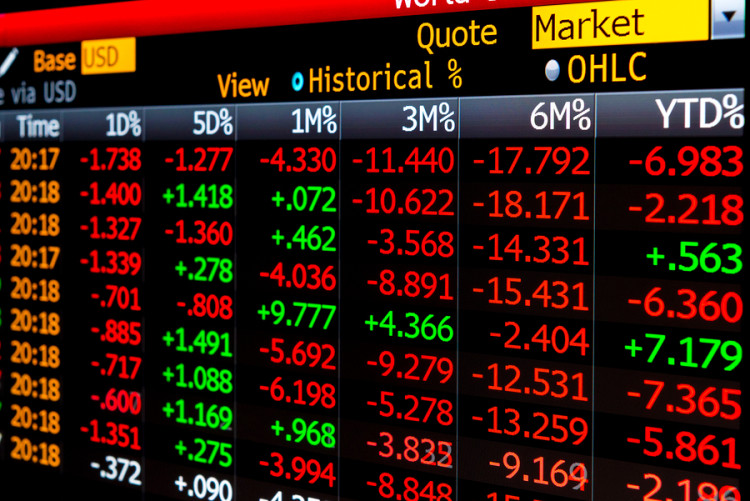U.S. Stocks Slide With Investors Wary on Growth Before Fed Meets

published Sep 16th 2016, 3:26 pm, by Dani Burger
(Bloomberg) —
U.S. stocks retreated to trim a weekly gain as investors awaited next week’s Federal Reserve meeting, with economic indicators pointing to uneven growth in the world’s largest economy.
Banks and energy producers carried the steepest losses Friday, with crude oil sinking to a one-month low. Sentiment soured on lenders as Deutsche Bank AG sparked a selloff in European banks after it rebuffed a Department of Justice offer to settle a financial crisis related probe for $14 billion. Oracle Corp. declined 4.8 percent after its quarterly revenue missed estimates. Intel Corp. climbed 3 percent after raising its sales forecast.
The S&P 500 Index fell 0.4 percent to 2,139.16 at 4 p.m. in New York, in heavy trading amid a quarterly event known as quadruple witching, when futures and options contracts on indexes and individual stocks expire. The Dow Jones Industrial Average lost 88.68 points, or 0.5 percent, to 18,123.80. The Nasdaq Composite Index declined 0.1 percent. About 9.5 billion shares changed hands on U.S. exchanges, 38 percent above the three-month average.
S&P Dow Jones Indices will also implement its quarterly index rebalancing after the close, including the first reboot of S&P 500 group weights in almost two decades. That will separate real estate investment trusts from the financial industry, creating 11 top-level groups.
“Oil heading toward below the 40’s is waking everyone up that it’s probably not going to recover fully,” Brian Frank, portfolio manager at Key Biscayne, Florida-based Frank Capital Partners LLC, said by phone. “You’ve got Deutsche Bank, which is scaring everybody. People are getting fed up with central banks. There’s a lot going on today.”
After the European Central Bank and the Bank of England kept monetary policies unchanged, attention is turning to the Fed’s meeting next week. The chances of a September rate increase are 20 percent, from 30 percent a week ago, with December the first month with more than even odds of a hike. Economists surveyed by Bloomberg expect the Fed to keep rates unchanged, while strengthening guidance about its intentions to raise borrowing costs soon.
With policy makers watching data for signs of stronger growth, a report today showed the cost of living in the U.S. rose more than projected in August, indicating inflation continues to move closer to the Fed’s goal. Separate data showed consumer confidence in September held at the lowest level since April, with views of current economic conditions falling to an almost one-year low. A Bloomberg gauge tracking the degree to which data miss or exceed economists’ estimates held near a two-month low.
“We had a couple of weaker economic numbers yesterday, so that heightens concerns about the macro picture in the U.S.,” said Patrick Spencer, the London-based vice chairman of equities at Robert W. Baird, which manages $151 billion. “The indexes are trading near all-time highs so some pullback isn’t surprising, but the longer-term trends remain robust so any correction is expected to be limited.”
Whipsaw Trading
The S&P 500 last struck an all-time high on Aug. 15, following a 26-session run that brought 10 such records. The gauge has since lost 2.3 percent. Equities whipsawed investors this week after a rout last Friday jolted markets out of their summer languor on concern that central banks are less willing to boost stimulus despite a persistently fragile global economy.
Even as stock slid today, the CBOE Volatility Index fell 5.7 percent to 15.37, extending its weekly decline to 12 percent. The measure of market turbulence known as the VIX surged last Friday by the most since Britain’s June vote to leave the European Union, and remains on pace for the biggest monthly jump since August 2015.
“The market is trading off of the Fed right now,” said Brent Schutte, who helps oversee $90 billion as chief investment strategist at Northwestern Mutual Wealth Management Company. “When the Fed starts pulling liquidity back, that increases volatility which will be heightened in the next six to nine months.”
Tech Strength
On the heels of its worst week since February, the main U.S. benchmark index rebounded in the latest five-day period, rising 0.5 percent. Apple Inc.’s 12 percent rally in the prior four days helped lift technology companies 3 percent. The group, which has a 21 percent weighting in the S&P 500, capped its best week since May.
In Friday’s trading, eight of the S&P 500’s 10 main industries fell, with financial, energy and industrial companies losing at least 0.7 percent. Utilities rallied for a third day, the longest winning streak in two months, while health-care shares were little changed.
Oil and gas companies sank as West Texas Intermediate crude futures fell 2 percent to barely hold above $43 a barrel. Chevron Corp. and Exxon Mobil Corp. slid more than 1.2 percent. Range Resources Corp. dropped 5.1 percent to an almost five-month low.
Technology shares lost momentum as Apple fell for the first time in five days, and Oracle posted the biggest slide this year to weigh on the group. Still, Intel’s rally to the highest since December 2014 helped keep declines in check.
Industrials in the benchmark fell to a 10-week low. United Technologies Corp. dropped 2.5 percent as Chief Executive Greg Hayes said the Pratt & Whitney unit will fall short of the 2016 target for deliveries of its new jet engine. W.W. Grainger Inc. slumped 4.3 percent amid concerns about competition from Amazon.com Inc.’s industrial distribution business.
–With assistance from Camila Russo. To contact the reporter on this story: Dani Burger in New York at dburger7@bloomberg.net To contact the editors responsible for this story: Cecile Vannucci at cvannucci1@bloomberg.net John Shipman, Alan Soughley
copyright
© 2016 Bloomberg L.P







No Comment